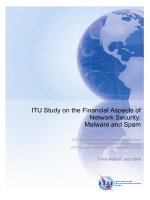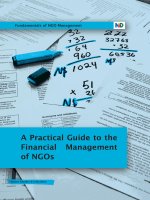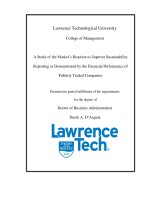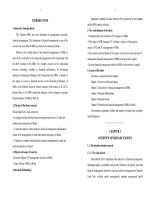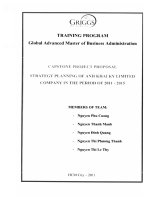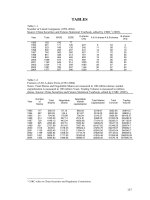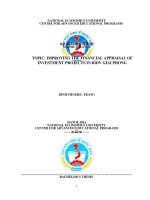24 THE FINANCIAL SITUATION OF ANH NGOC STEEL LIMITED LIABILITY COMPANY
Bạn đang xem bản rút gọn của tài liệu. Xem và tải ngay bản đầy đủ của tài liệu tại đây (509.71 KB, 107 trang )
MINISTRY OF FINANCE
ACADEMY OF FINANCE
----------
TRAN LE PHUOC AN
CQ55/11.02
GRADUATION THESIS
TOPIC:
THE FINANCIAL SITUATION OF ANH NGOC STEEL LIMITED
LIABILITY COMPANY
Major
: Corporate Finance
Student ID : 17523402010785
Supervisor
1
1
: Ph.D Pham Thi Thanh Hoa
HANOI - 2021
2
2
ACADEMY OF FINANCE
GRADUATION THESIS
DECLARATION
I hereby declare that this thesis is my own work and effort. It has not been
submitted anywhere for an award. Where other sources of information have been
used, they have been acknowledged.
Graduation thesis author
TRAN LE PHUOC AN
TRAN LE PHUOC AN
3
CQ55/11.02
ACADEMY OF FINANCE
GRADUATION THESIS
TABLE OF CONTENTS
TRAN LE PHUOC AN
4
CQ55/11.02
ACADEMY OF FINANCE
GRADUATION THESIS
TABLE
TRAN LE PHUOC AN
5
CQ55/11.02
ACADEMY OF FINANCE
GRADUATION THESIS
DIAGRAM
TRAN LE PHUOC AN
6
CQ55/11.02
ACADEMY OF FINANCE
GRADUATION THESIS
PREFACE
1.
Rationale of thesis
Vietnam's accession to WTO together with the removal of tariff barriers
has attracted companies operating in the pharmaceutical sector from abroad
with strong financial potential and modern technology. From there, it will
create a fiercer competitive environment for domestic pharmaceutical
manufacturing and trading enterprises in terms of price, quality and product
category.Facing that situation, the question for managers is how to build and
maintain a competitive advantage, thereby helping their businesses survive
and develop sustainably. There are many factors determining the
competitiveness of a business, of which corporate finance plays a very
important role. This is not only theoretically true but in practice has been
tested in many businesses, especially in large corporations and corporations
around the world. Understanding the financial situation is extremely
important to the survival of the business, through analysis of the financial
situation helps managers see the business performance and efficiency. how to
use capital? Is the allocation of capital reasonable? What factors affect the
business performance of the business.
During my internship at Anh Ngoc Steel Limited Company and being
aware of the importance of this issue, I chose the topic: “ The financial
situation of Anh Ngoc Steel Limited Liability Company”
2. Rearch objective
The topic goes into depth and explores issues related to the financial
situation of the business such as the general theory of corporate finance, the
indicators to evaluate the financial status of the business at Steel Limited
Liability Company Luster.
TRAN LE PHUOC AN
7
CQ55/11.02
ACADEMY OF FINANCE
GRADUATION THESIS
3. Research purposes:
The research project on financial status and financial solutions
implemented at Anh Ngoc Steel Company Limited proposes some
recommendation to improving the financial situation in Anh Ngoc Steel
Company limited in the future:
The thesis set out a number of tasks:
+ Systematize the theoretical issues of corporate finance and analyze the
corporate financial situation.
+
Review and evaluate the financial status of Anh Ngoc steel company limited
in 2020 on the basis of comparison with 2019 through the results achieved in
2 years.
+
Proposing a number of financial solutions to improve the financial situation,
improve operational efficiency at the unit in the coming time.
4. Research Methods
Research methods used in the thesis include:
+ Methods of data collection: interviewing methods, methods
observational investigation, more research method.
+ Methods of data analysis: comparison method, factor analysis method,
prediction method, Dupont method.
+ Graphical method, charting: By images, the properties of the graph, the chart
we can see the volatility, the structure, the role of the items and then analyze
the relationship, the level of influence. factors to the analysis criteria.
5. Research scope
+ In terms of space: Research on financial situation and financial measures to
improve the financial position of Anh Ngoc Steel Limited Liability Company.
+ About time: Financial activities of the company in 2020-2019.
+ Regarding data sources: The data are taken from accounting books, financial
TRAN LE PHUOC AN
8
CQ55/11.02
ACADEMY OF FINANCE
GRADUATION THESIS
statements for 2018, 2019 and 2020.
6. Thesis structure:
In addition to the introduction and conclusion, the content of the essay is
presented in three specific chapters as follows:
Chapter 1: Overview of financial situation of company
Chapter 2: Financial situation of Anh Ngoc steel company limited
Chapter 3: Main solutions to improve financial situation of Anh Ngoc Steel
company limited
My essay was completed thanks to the help and facilitation of the Board
of Directors, the uncles and sisters in the company, especially the dedicated
guidance and guidance of the teacher Associate Professor. Pham Thi Thanh
Hoa
However, due to the limited level and time, my writing cannot avoid its
shortcomings. So I look forward to receiving the teacher's guidance to make
my thesis more complete.
Thank you sincerely!
Hanoi, May 2021
Student
Tran Le Phuoc An
TRAN LE PHUOC AN
9
CQ55/11.02
ACADEMY OF FINANCE
GRADUATION THESIS
CHAPTER I
OVERVIEW OF FINANCIAL SITUATION OF COMPANY
1.1. Corporate finance and corporate finance management
1.1.1. Corporate finance and corporate finance decisions
1.1.1.1. Corporate finance
In general, corporate finance is an economic relationship in the form of
the resulting value associated with the creation and use of a company's
monetary funds to carry out its business.
Corporate finance deals with the financial structure of a corporation,
including its funding and the steps taken by the management to maximize the
value of the corporation. Corporate finance also involves methods and
research used to organize and distribute financial capital. The ultimate goal of
corporate finance is to optimize the value of a company through the
preparation and execution of capital, while balancing both profitability and
risk.
The arising economic relations associated with the creation, distribution
and usage of corporate monetary funds constitute the financial relationships
of the enterprise. In total, there are several financial relationships as
following:
-
Relationships between enterprises and the State: This is expressed in
the state funding of operating businesses and the financial
responsibilities of companies, such as the payment of taxes and fees,
etc.
-
Relationships between enterprises and other economic entities: This
involves payment relationships for borrowing and lending, capital
10
TRAN LE PHUOC AN
10
CQ55/11.02
ACADEMY OF FINANCE
GRADUATION THESIS
investment, purchasing or selling of properties, products, goods and
other services.
-
Other relationships (including relationships between enterprises and
labors, enterprises and shareholders and internal relations of
enterprises): This is reflected in enterprises’ payments of salaries,
wages, bonuses and fines to employees; the relationship between
departments of the company in the distribution of income after tax of
the business; dividend distribution to shareholders and establishment of
corporate funds, etc
1.1.1.2. Corporate finance decisions
Financial managers always have to make financial decisions to maximize
the value of the business. With every financial decision, managers are faced
with the conflict between risk and profitability and the balance of interests of
their stakeholders. A wise financial decision is to maximize the value of the
business, in order to do so, must ensure maximum profitability and minimize
risks for owners. Financial managers always have to analyze and make
important financial decisions to achieve the goals of the business. The essence
of financial decisions revolves around the decision to invest, the decision of
the capital and the decision to distribute profits.
Corporate finance has three major decisions:
* Investment Decision
Investment decisions are ones related to the total value of assets (shortterm assets and long-term assets). Investment decisions associated with the
left side of the balance sheet include:
-
Decisions on short-term assets investments: Inventories, policy on
selling goods, and short-term financial investments, etc.
11
TRAN LE PHUOC AN
11
CQ55/11.02
ACADEMY OF FINANCE
-
GRADUATION THESIS
Decisions on long-term assets investments: New fixed assets
purchase, old fixed assets replacements, project investments and
long-term financial investments, etc.
-
Decisions on structure of short-term and long-term assets: Operating
leverage usage and break-even point, etc.
* Financing Decision
Capital decisions include decisions about which funding sources to
choose to provide investment decisions. Major capital mobilization decisions
of enterprises include:
-
Decisions on short-term capital mobilization: Short-term loan or
commercial credit usage and short-term bank loan or corporate bills
usage, etc.
-
Decisions on long-term capital mobilization: Long-term debt or equity,
long-term borrowing from banks or corporate bonds issuance, etc.
* Dividend Decision
The decision about profit distribution is also known as the dividend
policy of the company. With this type of decision, the CFO will have to
choose between using after-tax profits to pay dividends or keep for
reinvestment. In addition, the CFO needs to decide which dividend policy to
follow and whether the dividend policy has any effect on the value of the
business or its stock market price.
12
TRAN LE PHUOC AN
12
CQ55/11.02
ACADEMY OF FINANCE
GRADUATION THESIS
1.1.2. Corporate finance management
1.1.2.1. Definition and roles of corporate finance management
Corporate financial governance is selecting, making decisions and
organizing the implementation of financial decisions in order to achieve the
business's operational goal of maximizing enterprise value. Because corporate
financial decisions are tied to the creation, distribution and use of a monetary
fund in the course of its operations, Corporate Financial Management is also
seen as a process of planning, organizing, implement, adjust and control the
process of creating, distributing, and using the monetary fund to meet the
operational needs of the business.
1.1.2.2. Tasks of corporate finance management
Corporate financial management is a part, the most important and
leading content of corporate governance, it has a close relationship and affects
all aspects of business operations. Most of the time, corporate governance
decisions are based on the results drawn from the financial evaluation of the
financial management of the business. This stems from the role of financial
governance for businesses.
Firstly, corporate financial management helps to mobilize capital,
ensuring the normal and continuous operation of the business.
Capital is the premise for business activities. During the operation of the
business, there are often needs for short and long term capital, meeting the
needs of production and business activities as well as investment and
development of the business. If the capital is not mobilized in time and
enough, it will make production and business activities difficult and cannot be
implemented. Financial managers based on consideration and analysis of
financial resources of the business, thereby giving an appropriate capital
mobilization policy, in accordance with the characteristics of operations,
13
TRAN LE PHUOC AN
13
CQ55/11.02
ACADEMY OF FINANCE
GRADUATION THESIS
business, available capital of the business. To maximize the advantages of
using capital, in order to minimize risks and maximize business value.
Secondly, corporate financial management helps organize and use
capital economically and effectively, contributing to improving the efficiency
of business operations.
Timely and fully organizing and mobilizing capital will help businesses
grasp business opportunities, increase revenue and profits for businesses.
Choosing the appropriate form and method of capital mobilization will help
businesses reduce the cost of capital, improve capital efficiency, and increase
profits for owners.
Thirdly, Corporate Financial Management helps to comprehensively
inspect and supervise all aspects of production and business activities of
enterprises.
Through reviewing, examining, assessing the situation of monetary
revenues and expenditures, analyzing and evaluating the financial situation of
the business, financial managers can promptly and comprehensively control
all aspects of operations. point out the shortcomings, limitations and
unexploited potentials to propose solutions, adjust business operations to
achieve the business objectives set out.
Today, corporate financial management plays an increasingly important
role in making strategic and tactical decisions based on the analysis and
evaluation of financial managers. Make an important contribution to
promoting and improving the efficiency of production and business of
enterprises in the current period.
1.1.2.3. The content of corporate financial management
Corporate financial governance includes the following main contents:
14
TRAN LE PHUOC AN
14
CQ55/11.02
ACADEMY OF FINANCE
GRADUATION THESIS
Firstly, participate in the evaluation and selection of investment
decisions.
The prospect of a business in the future depends greatly on its
investment decisions, especially long-term decisions with large capital scale.
To come to an investment decision, it is required that the financial
administrator to counterattack the economic, technical and financial aspects.
In which, in the financial sector, the manager must evaluate the potential of
investment opportunities by calculating the cash inflow, cash outflow, net
cash flow of the project to evaluate the benefits. profit, financial efficiency
brought from investment opportunities.
Secondly, determine capital needs and mobilize capital to promptly and
adequately meet capital needs for business activities.
The enterprise's financial manager must determine the need for shortterm capital and long-term capital of the enterprise to organize and mobilize
capital based on capital structure, advantages and disadvantages of each form.
to mobilize capital and expenses for the use of such capital in order to
promptly and fully meet the enterprises' capital needs and production and
business demands.
Thirdly, efficiently use the existing capital, strictly manage revenues
and expenditures, ensure the solvency of the business.
Financial managers must find measures to maximize the capital
mobilization of enterprises to serve production and business activities, and at
the same time release stagnant capital, closely monitor and manage jobs.
make payments, recover sales and other revenues, strictly manage all costs
incurred in the operation of the business. From there, establishing measures to
ensure the balance between capital revenues and expenditures in cash,
ensuring the solvency of the due debts of the business.
15
TRAN LE PHUOC AN
15
CQ55/11.02
ACADEMY OF FINANCE
GRADUATION THESIS
Fourthly, implementing profit distribution, setting up and using
corporate funds.
The after-tax profit distribution policy, setting up and using funds play a
very important role, affecting internally - the spiritual life of employees, and
at the same time affecting the development of enterprise. The appropriateness
of appropriation and distribution of profits helps enterprises to harmonize the
immediate interests - the interests of the owners and the long-term benefits the development of the business.
Fifthly, regularly control the operating situation of the business.
Through analyzing financial statements, financial indicators, daily cash
collection and spending, financial managers can control business operations.
At the same time, through the analysis of the financial indicators of the
business, the managers can understand the strengths, weaknesses, capital
efficiency, profitability ratio, and forecast the financial situation in the short
term. . Helping financial managers to capture and control, make timely
financial decisions to adjust the production, business, and finance of the
business.
Sixthly, implementation of financial planning.
In order for the financial operations of the business to take place
regularly and continuously, financial managers need to make financial plans
to make the right financial decisions to achieve maximum goals. Enterprise
value. The implementation of a financial plan is considered an active process
when proposing solutions and development paths for businesses during
market volatility.
16
TRAN LE PHUOC AN
16
CQ55/11.02
ACADEMY OF FINANCE
GRADUATION THESIS
1.2. Financial situation of an enterprise
1.2.1. Definition of financial situation of a company
Assessment of financial situation of an enterprise is the analysis of the
results of financial management through financial statements using a
combination of methods, tools and analytical techniques. Through financial
situation of an enterprise, strengths and weaknesses of the company can be
identified, thereby setting out suitable measurements to improve the quality of
its production and business.
Financial activities have a direct relationship with the production and
business activities of an enterprise. Therefore, assessing the financial situation
of enterprises needs to achieve the following objectives:
-
Accurately assess the financial situation of the enterprise in various
aspects such as capital structure, assets, solvency, cash flow, asset use
efficiency, profitability and risk financial risks, etc. for managementlevel staff, tax authorities, auditors and employees.
-
Orient the decisions of the managers in the direction suitable to the
actual situation of the enterprises
-
Build a basic premise for financial forecasts, helping analysts predict
the financial potential of the business in the future.
-
Act as a tool to control the business activities of the enterprise on the
basis of comparing the achieved targets with the planned targets. From
that point of view, it will help identify strengths and weaknesses in
business activities, help make the right decisions for high-efficient
business.
17
TRAN LE PHUOC AN
17
CQ55/11.02
ACADEMY OF FINANCE
GRADUATION THESIS
1.2.2. Indicators reflecting financial situation
To accurately and fully reflect the financial situation of an enterprise, it
is necessary to study and analyze the following indicators:
1.2.2.1. Asset and asset structure
By analyzing the situation of assets, investors will know how companies
allocate their mobilized capital, and understand whether the use of raised
capital is suitable for the business or not.
The structure of assets is analyzed by calculating and comparing the
fluctuation between the analysis period and the base period in proportion of
each asset, including current & non-current assets, receivables, inventories
and cash, etc. in total assets.
The analysis of proportion of each asset allows finance managers and
investors to assess the allocation and usage of capital; however, they cannot
know the affecting factors to the fluctuations in asset structure. Therefore, it is
necessary to apply a combination of both horizontal and absolute analysis, as
well as analysis of each type of asset over total assets to see their trends over
time. Thereby, we can evaluate the appropriateness of the allocation. The
assessment must be based on the business nature and the fluctuation of each
part of the enterprise. At the same time, the evaluation data used is the ones of
enterprises over the years, along with information about the general structure
and competitors of the industry in the latest years.
1.2.2.2. Sources of capital and capital structure
a. Scale and structure of equity
Equity is the capital owned by the business owners and members of the
joint venture company or the shareholders in the joint stock companies; and
the amount or assets that the investors contributed initially and added in the
business process. Thus, a number of other expenses incurred in the business
18
TRAN LE PHUOC AN
18
CQ55/11.02
ACADEMY OF FINANCE
GRADUATION THESIS
process such as undistributed after-tax profit, corporate funds, revaluation
differences, exchange rate differences, etc. are parts of equity.
Unlike equity, liabilities reflect the amount of capital that a business
borrows during its business operations. Therefore, businesses must commit
and be responsible for payment. Liabilities include many different types,
classified in different ways but the most common application is still based on
the payment term: short-term and long-term.
By analyzing the capital structure, managers will understand the capital
mobilization structure and the responsibilities of businesses to investors,
suppliers and employees about the number of assets financed by their capital.
Besides, with the analysis, it is also possible to know the financial
independence of the enterprise as well as the fluctuation trend in the structure
of mobilized capital.
The analysis of capital structure needs to calculate and compare the
situation of fluctuations between the analysis period and the base period on
the proportion of each capital source in the total capital.
Debt ratio =
Equity ratio =
The analysis and comparison of this fluctuation situation allow managers
to assess the structure of mobilized capital; however, they cannot know the
affecting factors to the fluctuations in capital structure. Therefore, it must be
combined with horizontal analysis of both absolute and relative numbers as
well as analysis by each type of capital. In addition, it is necessary to consider
their fluctuations over time to adjust the level of rationality, ensure business
efficiency and financial security of enterprises. It is possible to review and
compare the fluctuations in the proportion of capital by each capital source of
the enterprise over years and compared with the general structure of the
industry.
19
TRAN LE PHUOC AN
19
CQ55/11.02
ACADEMY OF FINANCE
GRADUATION THESIS
The above analysis allows managers to assess the financial capacity as
well as the level of financial independence of the business. If the equity
constitutes a high proportion of the total capital, the enterprise has sufficient
financial self-sufficiency and a high degree of financial independence. On the
contrary, if the liabilities account for a high proportion of the total capital, the
financial security of the enterprise is not sustainable.
Moreover, by analyzing the capital structure, the financial analysts of
enterprises will understand several indicators: debt ratio compared with
equity, debt ratio to total capital and funding coefficient. These three
indicators all reflect the level of financial independence of the business. To be
specific, the higher the debt to equity ratio and the higher the debt to equity
ratio, the lower the financial independence of the business and vice versa; the
higher the coefficient of funding, the higher the level of financial
independence and vice versa.
Last but not least, to assess the level of financial security and rationality
in allocating capital structure, finance executives need to pay close attention
to capital mobilization policies and investment policies in each period of the
business.
b. Capital structure model
In industry, cooperation between liabilities and equity is important in
order to make the most of external capital while guaranteeing corporate
financial stability. Resource support for corporate development and market
operations can be considered and measured by client sponsorship policies:
Net working capital = Long term capital – Long term assets
= Short term assets – Short term capital
NWC > 0: According to the first formula, it proves that enterprises have
surplus long-term capital; Equity and long-term debt allow full financing for
fixed assets and long-term investments, while it partially funds short-term
fixed and liquid assets, and corporate finance is balanced. According to the
20
TRAN LE PHUOC AN
20
CQ55/11.02
ACADEMY OF FINANCE
GRADUATION THESIS
second formula, the proceeds from current assets and short-term investments
will enable the business to not only be able to pay due debts, but also to spend
a certain amount of money. Therefore, corporate finance will balance in the
short term.
NWC <0: According to the first formula, it shows that long-term capital
is only partially secured for long-term assets, while the remaining part
of the capital is used in short-term to finance long-term assets. Thus,
corporate finance is not balanced. According to the second formula, it
shows that money that can be obtained from current assets and shortterm investments is insufficient to cover short-term debt so short-term
balances are not guaranteed in the short.
NWC = 0: If current assets are equal to short-term liabilities, or regular
capital is equal to fixed assets, NWC = 0. This kind of financing shows
that only fixed assets are financed by long-term capital, while current
assets are financed by short-term capital. This case does not create
stability in the production and business activities of enterprises,
especially for industries with slow capital turnover.
(Source: Academy of Finance Corporate Finance Textbook)
Diagram 1.1: Three models in using working capital of a company
21
TRAN LE PHUOC AN
21
CQ55/11.02
ACADEMY OF FINANCE
GRADUATION THESIS
In order to facilitate the flexible use of financial resources, consider the
following funding models:
* 1st Model: Fixed assets and part of current assets are financed by longterm financial resources while temporary working capital are financed by
temporary financial resources. By applying this model, businesses can reduce
payment risk, ensuring higher level of safety and reduce the cost of capital
use. However, there is one weakness that there is no flexibility in the
organization of capital use.
* 2nd Model: All fixed assets, current assets and part of current assets
are secured by regular capital, and part of the remaining temporary assets is
secured by temporary capital. By using this model, we can ensure high
affordability and safety. Nevetheless, companies must utilize more long-term
and medium-term loans as to pay more for the use of capital.
* 3rd Model: All fixed assets and part of current assets are secured by
regular capital, while part of current assets and all temporary assets are
secured by temporary capital.
1.2.2.3. Revenue, Expenses and Income
In order to evaluate the business performance on the distribution and use
of monetary funds, it is necessary to analyze the criteria of Revenue,
expenses, profits, ... on the report on business results. of the business.
Revenue - Cost = Profit
- Turnover: Is the expression of the total value of economic benefits earned
by the enterprise from business activities and other activities in a certain
period of time.
Revenue structure includes the following divisions:
+ Revenue from production and business activities
22
TRAN LE PHUOC AN
22
CQ55/11.02
ACADEMY OF FINANCE
GRADUATION THESIS
+ Revenue from financial activities
+ Other income
- Costs: are the expenses expressed in money in the production and business
process with the desire to create products, services or a certain business result
in a certain period of time.
The cost structure includes the following parts:
+ Production and business costs
+ Financial expenses
+ Other costs
Some indicators reflect the cost management situation:
* Cost coefficient: Reflecting in order to get one dong of revenue, how much
expense must businesses spend. The size of the business organization, the
level of cost management affects this indicator.
Cost coefficient =
* Coefficient of cost of goods sold ( COGS): Reflecting how much VND the
enterprise spends in its revenue. The level of cost management in the business
has a great influence on this indicator.
COGS coefficient =
* Selling expense coefficient: Reflecting how much VND the enterprise
spends on selling expenses for every VND of revenue to sell products.
Selling expense coefficient =
* Administration expense coefficient: Reflecting for every VND of revenue,
how much VND does the enterprise spend to manage the business (cost of
management staff, cost of management materials, ...)
Administration expense coefficient =
23
TRAN LE PHUOC AN
23
CQ55/11.02
ACADEMY OF FINANCE
GRADUATION THESIS
- Profit: This is the difference between the revenue and the expense on the
business statement, this is the index calculated as the basis for evaluating the
performance of the business. From a financial perspective, maximizing profit
and minimizing risk is the goal that every business always aims for.
Analyzing and proposing suitable financial plans in each stage will help
increase revenue, save costs, and achieve goals consistent with the company's
development orientation.
1.2.2.4. Cash flow
From the perspective of corporate financial managers, the assessment of
the ability of the business to generate money to consider the payment criteria
of due debts is extremely important. To evaluate these ratios in terms of
corporate finance, financial managers use the cash flow target on the CFS. For
an enterprise, when performing economic activities, cash inflow and cash
outflow will arise in the enterprise.
Content of the enterprise's cash flows:
Cash flow of a business includes cash inflow, cash outflow, net cash flow
* Cash inflows: Cash flows that arise into the business during its operations,
including revenues from selling products, goods, providing services,
borrowing, issuing stocks, bonds, ...
* Cash outflow: Cash flow arises out of the business during its operation,
including spending on property purchases, paying for raw materials, paying
salaries, debt repayments, loan interests, ...
* Net cash flow: Is the difference between the cash inflow and the cash
outflow of the business.
Net cash flow = Cash inflow – Cash outflow
24
TRAN LE PHUOC AN
24
CQ55/11.02
ACADEMY OF FINANCE
GRADUATION THESIS
In the operating cash flow of a business, the cash flow from operating
activities is the most important cash flow, this is the most frequent and stable
cash flow for the operations of the business.
To evaluate the cash flow situation of an enterprise, assess some of the
following criteria:
Cash conversion cycle ( CCC):
* Days sale outstanding: Is the average number of days from giving debt
to a customer until recovery of a customer's receivable debt is recovered.
Days sale outstanding =
* Days payable outstanding: Is the average number of days from
purchasing raw materials or goods until the business pays the supplier.
Days payable outstanding =
* Days inventory outstanding: It is the average number of days between
the time NVL, the goods are stored in the warehouse until it is sold to the
customer.
Days inventory outstanding =
Cash conversion cycle = Days sale outstanding+ Days inventory
outstanding- Days payable outstanding
Enterprises always come up with a reasonable strategy between the
appropriated capital and the appropriated capital, in order to meet the different
operational goals of the business, while increasing the ability to create money
to create liquidity and ensure guarantee the ability to pay debts in order to
reduce the time to convert money into money of the business.
Criteria for assessing the cash flow of an enterprise:
25
TRAN LE PHUOC AN
25
CQ55/11.02

